Laptop Mag Verdict
Samsung's Galaxy Note 3 packs robust pen and multitasking software in a sleek, speedy, long-lasting device with a brilliant display.
Pros
- +
Improved design
- +
Excellent S Pen and multitasking software
- +
Best-in-class performance
- +
Brilliant display
- +
Long-lasting battery
Cons
- -
No Spark compatibility
- -
Small LTE network
Why you can trust Laptop Mag
Samsung continues to augment its line of supersize smartphones -- this time, with the $249 Galaxy Note 3. Packing a bigger screen and faster processor into a sleeker package than its predecessor, the Note 3 on Sprint boasts a brilliant display and epic battery life. An onboard stylus and Samsung's robust note-taking and multitasking software make this phablet a superior productivity device. Is the Note 3 the Android smartphone to get? Read on.
Design
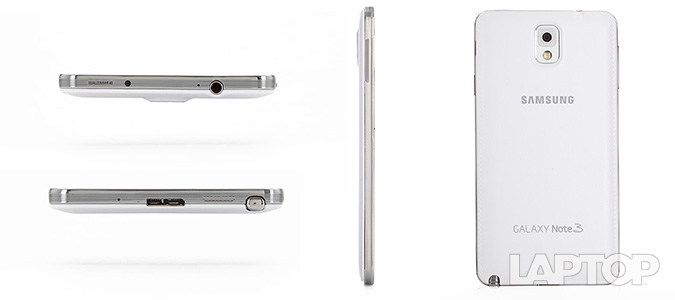
Thankfully, Samsung ditched the cheap-looking glossy plastic of the Note 2 for a faux-leather back with stitching along the edges on the Note 3. We prefer this look, as it adds a touch of class while providing an easy grip. Pop off the back, and you get access to the battery and a microSD card slot that takes memory cards with capacities of up to 64GB.
The shiny, chrome sides of the Note 3 house a volume rocker (left), a hold button (right), a 3.5mm audio jack (top), and a microUSB 3.0 port, a speaker and an inconspicuously docked stylus (bottom). While we love how seamlessly the stylus is docked onto the Note 3, it can be a little difficult to remove.
At 5.95 x 3.12 x 0.33 inches, the Note 3 is thinner and smaller than the Note 2 (5.9 x 3.2 x 0.37 inches) despite having a larger screen. It's also smaller than the HTC One Max (6.5 x 3.2 x 0.41 inches) and the Samsung Galaxy Mega (6.6 x 3.5 x 0.31 inches), but larger than the LG G2 (5.45 x 2.79 x 0.35 inches). Granted, the G2 has a smaller 5.2-inch screen, while the One Max and the Mega sport larger 5.9-inch and 6.3-inch displays, respectively.
MORE: Hyperion Extended Battery Nearly Doubles Battery Life of Galaxy Note 3
Weighing 5.93 ounces, the Note 3 is also lighter than the 6.3-ounce Note 2, the 7.7-ounce One Max and the 7-ounce Mega. It's heavier than the G2 (5.04 ounces), which is a smaller device.
Display
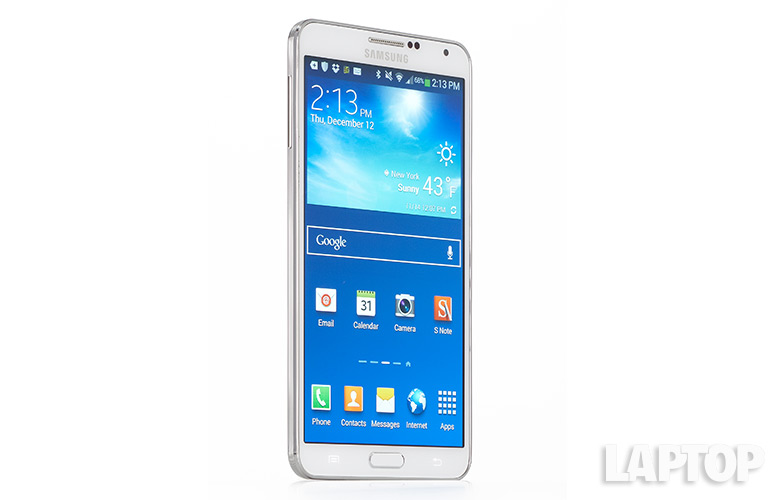
Click to EnlargeYou'll love watching videos and playing games on the Note 3's gorgeous 5.7-inch 1920 x 1080-pixel Super AMOLED screen. A 1080p trailer for "The Wolf of Wall Street" was a delight to watch, as the bright-yellow title cards and Jonah Hill's colorful, patchwork shirt really popped. Details were so clear that we could see individual lines on Leonardo DiCaprio's blue pinstriped suit. Viewing angles were generous, and colors remained true, even when we tilted the phone to extreme angles.
We watched the same trailer on the One Max (1920 x 1080p) and the Galaxy Mega (1280 x 720p). At all viewing angles, the Note 3 clearly had the boldest display. The Note 3 delivered slightly more saturated images and deeper blacks than the One Max, but the display quality wasn't as sharp.
With its bright screen, the Note 3 is not only good for outdoor viewing, but also for lighting up an entire campsite. At 550 lux on our light meter, the Note 3 was significantly brighter than the smartphone category average (405 lux), the Mega (398 lux), the Verizon G2 (351 lux) and the One Max (441 lux).
Audio
The modest speaker on the Note 3's bottom edge offered tinny but booming sound at max volume. We listened to "Roar" by Katy Perry, and her voice sounded canned. Likewise, the instrument-heavy "I Follow Rivers" by Lykke Li sounded particularly industrial, thanks to the harsh echoes from the Note 3.
In contrast, "Roar" sounded whole and distinct on the One Max, which features front-facing BoomSound speakers. We could easily distinguish between Perry's roaring voice and the drums and synths in the background.
MORE: Top Smartphone Gifts
On the LAPTOP Audio Test (measuring volume from 13 inches), the Note 3 registered 78 dB, which is just shy of the smartphone category average (80 dB) and the Verizon G2 (79 dB). It's also softer than the Mega and the One Max, which both hit 83 dB.
Keyboard
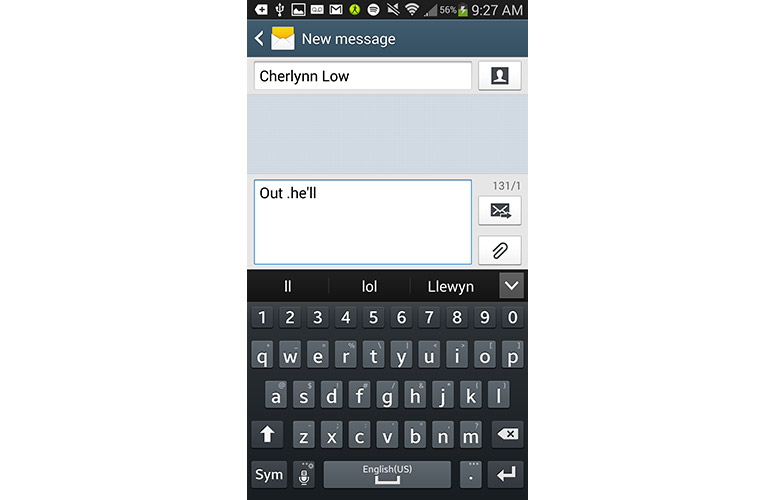
Click to EnlargeWith its large display, well-spaced keys and strong haptic feedback, the keyboard on the Note 3 is one of the best we've used. Two-handed typing was easy and accurate, but trying to type with one hand was sometimes a challenge with the keyboard at full screen. Fortunately, Samsung provides a floating keyboard that can be docked to either side of the screen for both left- and right-handed users. This keyboard is slightly squashed, so you'll have to be extra careful when composing your message, but it's a good compromise for that urgent text on the go.
You also get standard keyboard features, such as next-word prediction, Swype trace typing and Google voice typing.
Software and User Interface
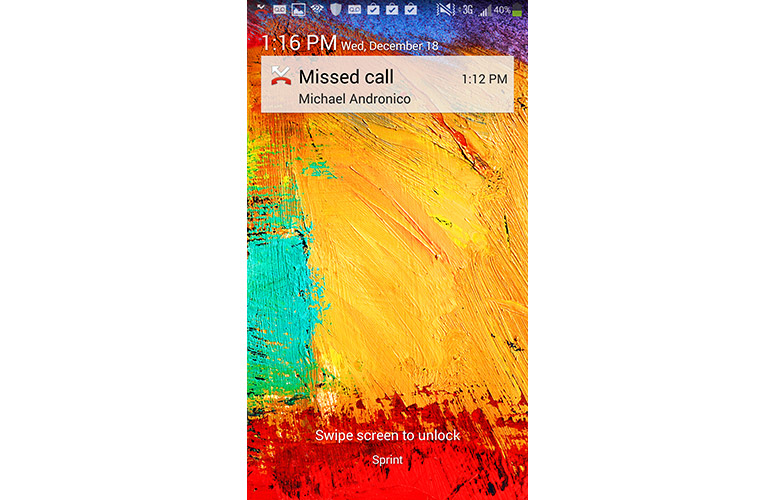
Click to EnlargeRunning Android 4.3 Jelly Bean with Samsung's TouchWiz overlay, the Note 3 was a joy to use. On the lock screen sits a clock widget, which you can customize to show your favorite apps when you swipe left. You can personalize up to seven home screens with your preferred apps and widgets. Swiping from the top brings down a notifications shade, which lets you quickly access 20 connectivity and device settings, as well as a toggle to adjust the display brightness.
MORE: Top Holiday Gift Ideas 2013
Samsung is aware that the Note 3 is a beast to hold, and packs some features that make it easier to use with just one hand. When you go into the One-Handed Operation Settings menu, you can enable "Use for all screens," which lets you shrink the entire display and dock it wherever you want. You can activate this with a quick back-and-forth swipe, and a resizable frame pops up to surround the screen. The home, menu, back and volume buttons are at the bottom for easy one-handed use.
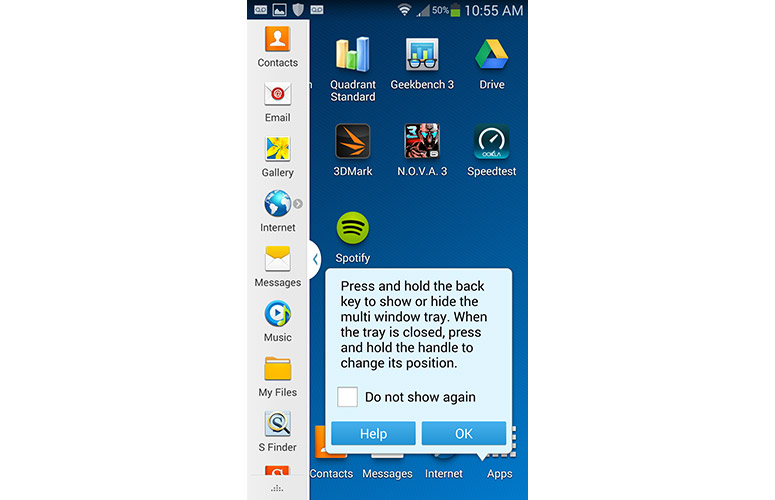
Click to EnlargeTo make better use of the generous screen space, Samsung further improved its Multi Window feature, which lets you split the screen between two apps, by adding an automatic option -- so when you hit links in Twitter or Facebook, they open in another pane. Some 20 programs are now available as Multi Window apps, including Polaris Office 5, Gmail, Chrome, Play Books, S Note and Hangouts. Samsung has made it possible for developers to code their apps to be compatible with Multi Window, so we can expect the split-screen functionality to be available on more apps over time.
Air Command
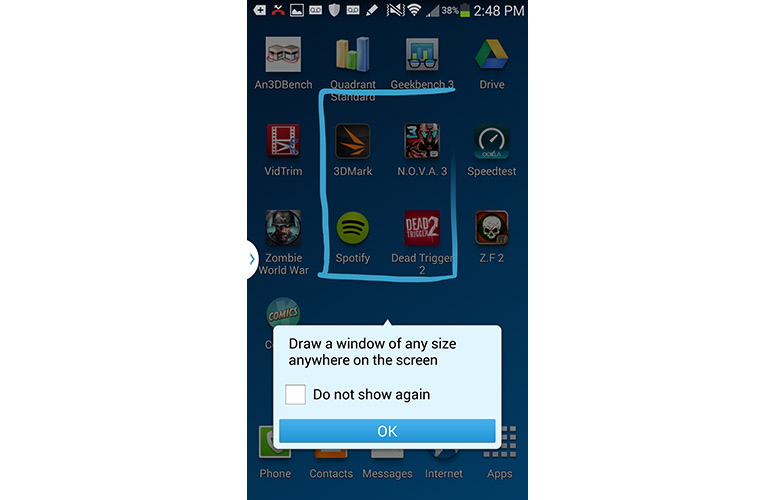
Click to EnlargeOf all the software that Samsung packed into the Note 3, we especially like the Air Command feature, which makes it easy to access pen-enabled features. Triggered when you pull out the stylus or click the pen button while hovering over the screen, the Air Command menu fans out to show five utilities: Action Memo, Scrapbooker, Screen Write, S Finder and Pen Window.
Action Memo lets you write down tasks and perform them, such as writing down a phone number and adding it to your contacts. Samsung recommends that you write in a straight line so the phone can better recognize your instructions. We added "Buy Shampoo" to our calendar easily enough, but it wasn't significantly faster than adding it to the calendar without Action Memo.
Scrapbooker lets you capture whatever is on your phone's screen by circling it. The snippet gets stored to your Note 3 along with metadata, such as a link to the page (if your memo was from a website) or video (from YouTube app). We circled an ad for the Nexus 7, and Scrapbooker captured an image of the search results, along with a transcription of the accompanying text, the title of the page we snapped and a direct URL.
MORE: 6 Hottest Smartphones Right Now
S Finder lets you search items within the Note 3 -- including text messages, phone logs, emails and handwritten notes -- and even connects to apps you have on the phone, such as IMDb and Yelp. You can use filters such as Yesterday or Past 7 Days to pull up all content associated with that time. We did a search for "images" and selected Yesterday, and the Note 3 immediately returned 40 pictures we took yesterday.
Our favorite of the Air Command apps is Pen Window, which launches a floating window of any size you draw. You can launch Calculator, Clock, YouTube, Phone, Contacts, Hangouts or Internet in a Pen Window, and open all of these on your screen at once. These apps will float on top of any content on your phone, so you can have a chat open in Hangouts while you watch a movie, or have the phone dialer floating as you look up a list of phone numbers.
Performance
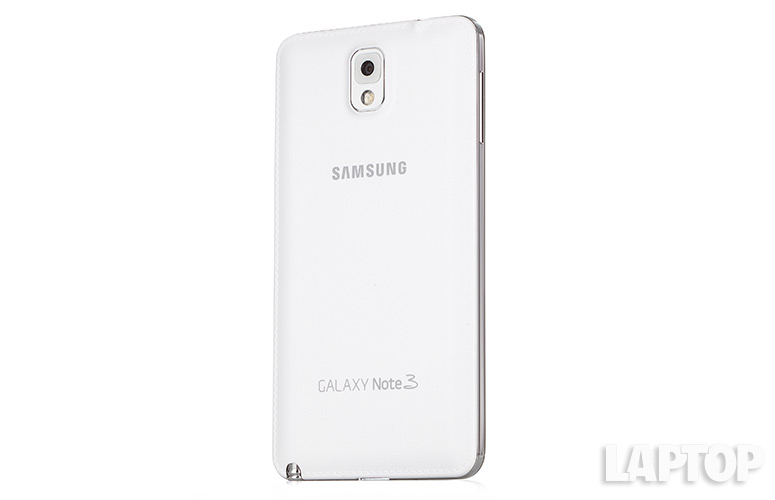
Click to EnlargePacking a 2.3-GHz quad-core Snapdragon 800 chip with 3GB of RAM, the speedy Note 3 was a joy to use. We played rounds of "Zombie Frontier 2" without a hiccup while Camera, Browser, Gallery, Google Play store, S Note, Settings, Spotify and Video Player were open in the background. The camera effortlessly snapped five successive shots in a second, and returning to the home screen was almost instantaneous.
The graphics-intensive first-person shooter "N.O.V.A. 3" loaded in just 13 seconds on the Note 3. That's faster than the average smartphone (15 seconds), the Snapdragon 600-powered One Max (16 seconds) and the Snapdragon S4 Pro-powered Mega (17 seconds).
The Note 3 blew away the competition on benchmarks. Scoring 2,983 on Geekbench 3, a synthetic test, it outdid the average smartphone (1,626), the One Max (1,902), the Mega (1,129) and the LG G2 (1,595).
It performed similarly well on Quadrant, pulling 20,585. That's more than twice the average smartphone (7,706) and the Mega (8,565). It's also significantly better than the One Max (11,981) and the Verizon LG G2 (16,960).
You'll be able to use the Note 3 to quickly complete heavy-duty tasks. The Note 3 converted a 200MB 1080p video to 480p on VidTrim in just 5 minutes and 12 seconds. That's 3 full minutes faster than the average smartphone (8:18) and about 2 minutes faster than the Mega (7:39), the One Max (7:33) and the Verizon LG G2 (7:04).
The Note 3 continued to impress when it came to graphics, as it notched an impressive 18,925 on 3DMark Ice Storm Unlimited, besting the smartphone category average (9,913), the Mega (4,550), the One Max (10,984) and the Verizon G2 (14,762).
Apps
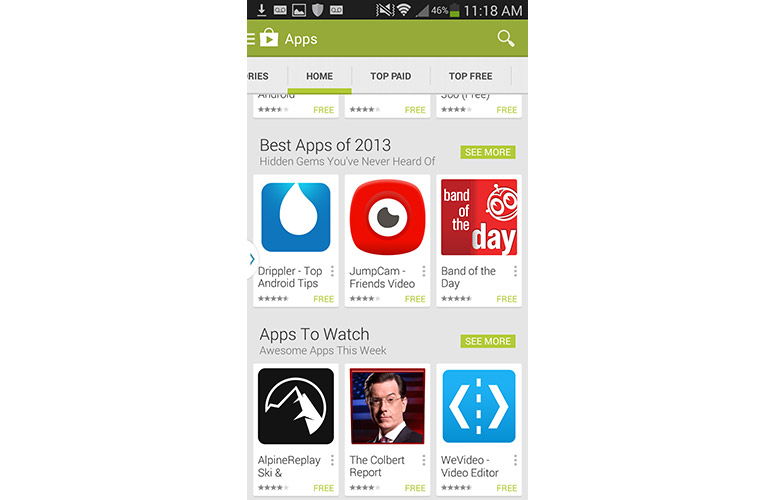
Click to EnlargeThe Note 3 comes packed with a robust suite of Samsung apps, including the useful S Health, S Translator, S Voice and WatchON. We especially liked S Health, which helped us set -- and achieve -- fitness goals.
Sprint apps include Sprint Zone, BaconReader (for Reddit), 1Weather, NextRadio, Scout (GPS Navigation) and Sprint TV & Movies.
The device also comes with standard Android apps, such as Gmail, YouTube, Calculator, Maps and Drive.
MORE: Samsung Galaxy Note 3 vs. Galaxy S4: Which Phone Is Best?
Camera
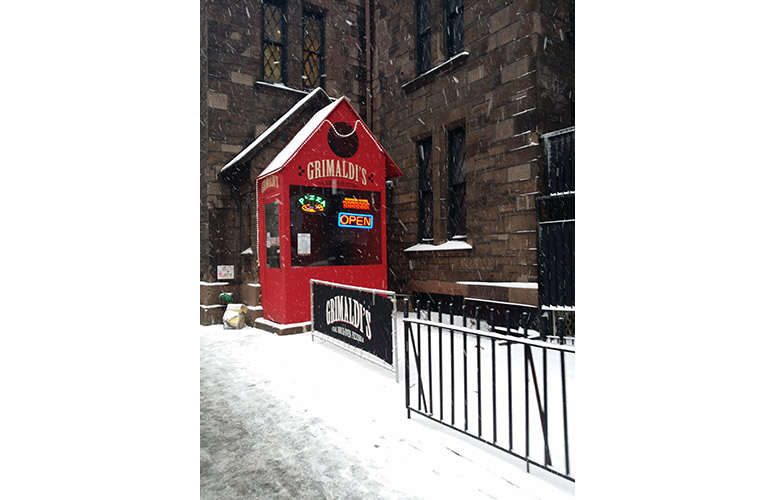
Click to EnlargeThe 13-MP rear camera on the Note 3 took sharp, vibrant photos. Our shots of Manhattan buildings on a snowy day were so clear we could see individual falling snowflakes against an old brick building. Yellow cabs and red awnings popped even on an overcast day. We also loved the camera's ability to take clear pictures on the streets at night, delivering beautiful images of a whimsical Christmas display.
The phone captured vivid 1080p video that was crisp and colorful. Clips of New York streets on a snowy day rendered lively yellows and reds.
[sc:video id="hlaXE1cToJJ5L-Y01AVhJdkwkScB-woZ" width="575" height="398"]
Up front, the 2-MP camera shot bright, detailed images. Our pastel pink shirt and blue cookie wrapper were accurately colored. Blemishes on our face were (unfortunately) visible, but we easily erased them with the built-in Beauty mode.
Camera Features
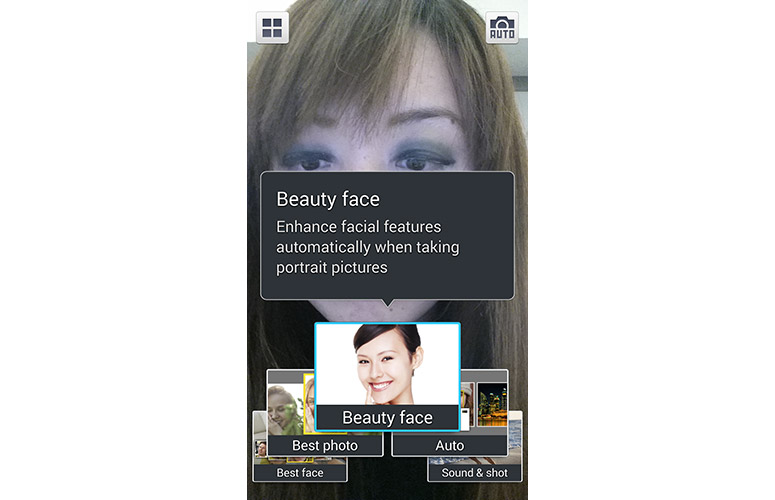
Click to EnlargeSamsung packed the camera with its usual suite of special features, including Best Face, Best Shot, Sports, Panorama, HDR, Golf, Animated Photo, Sound & Shot, Drama, Surround Shot and Eraser modes.
Meant for the duffer looking to improve his game, Golf mode takes pictures of a swing and lets you view the frames. Eraser mode takes a series of shots and removes moving strangers, while Drama Shot snaps multiple images and merges them to show the motion of an object through the scene. Surround Shot takes a 360-degree panorama, while Sound & Shot captures a snippet of noise along with your picture.
You can also adjust specific settings -- such as Metering, ISO, Smart Stabilization, White Balance and Exposure -- by tapping the gear icon on the shutter screen.
4G LTE
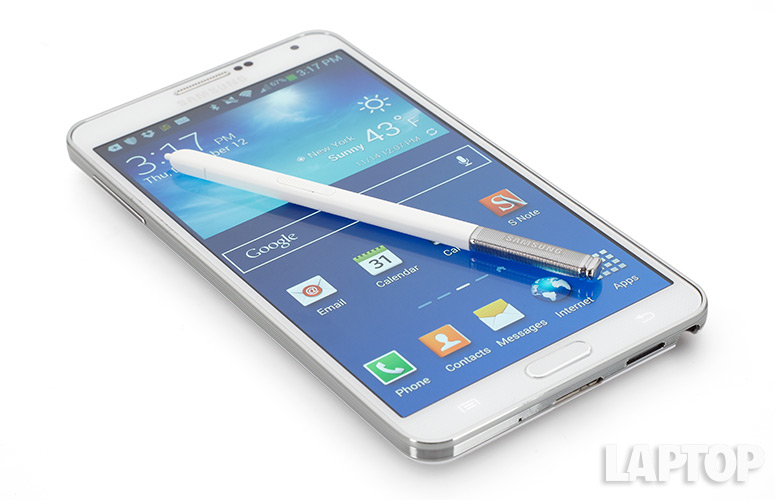
Click to EnlargeOne limitation of the Note 3 is that it isn't compatible with Sprint's new Spark network, which delivers much faster data speeds. On Spark, LTE speeds can reach up to 60 Mbps, so, as Sprint says, a 60-minute HD video can take just 2.5 minutes to download. While Spark is only currently available in five markets, the company intends to bring the service to the rest of the nation over the next three years.
Until Sprint launches Spark-enhanced versions of the Note 3, you are stuck with the carrier's slower 4G LTE network, which covers just 300 markets. In comparison, Verizon and AT&T already have more than 500 and 488 markets, respectively.
We tested the Note 3, the Mega and the One Max (the latter two on Spark) at various Manhattan locations. On the corner of 63rd Street and Lexington Avenue, the Note 3 averaged 8.46 Mbps down and 6.41 Mbps up. That's about half the speeds delivered by the Spark-enabled Mega (16.2 Mbps down, 13.24 Mbps up) and the One Max (17.5 Mbps down, 17.8 Mbps up).
It took 4 minutes and 41 seconds to download a 200MB trailer on the Note 3, while the same file was downloaded in just less than 2 minutes with the Mega (1:44) and One Max (1:45) on Spark.
We saw similarly slow speeds at another test location (the corner of 56th Street and Lexington Avenue), with the Note 3 taking 5 minutes and 23 seconds to download a 238MB trailer. At this location, the same file took less than a minute to download over Spark on the Mega (53 seconds) and the One Max (53.55 seconds).
Battery Life and Call Quality
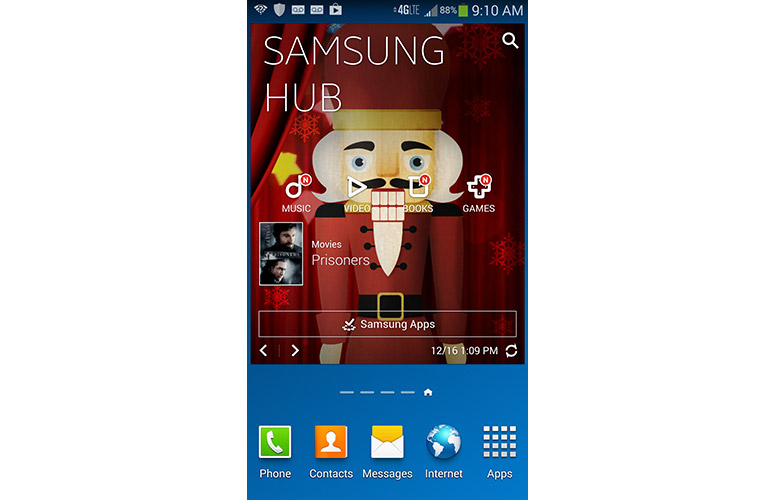
Click to EnlargeYou won't have to rush home to charge your phone, thanks to the Note 3's generous 3,200-mAh battery, which promises up to 23 hours of talk time on Sprint's network.
On the LAPTOP Battery Test, which involves continuous Web surfing over 4G with the display on 40 percent brightness, the Note 3 lasted an impressive 8 hours and 48 minutes. That's two entire hours longer than the average smartphone (6:41) and more than the Mega (7:13) and the One Max (8:32). However, the T-Mobile version of the Note 3 lasted a full 11 hours and 15 minutes.
It was easy to hear our friends when we made calls to New York City phones from Union Square, and they reported being able to make us out clearly. While the phone is bigger than most handsets, we didn't feel awkward holding it to our face to place a call.
MORE: 10 Tablets with the Longest Battery Life
Plans and Pricing
With a two-year plan on Sprint, the Galaxy Note 3 will set you back $349 up front, but new customers bringing a number to Sprint get $100 off. The carrier offers unlimited talk, text and data for $110 a month with its My All-In plan, or unlimited talk and text starting at $50 monthly with optional data add-ons.
If you get Sprint's Unlimited My All-In plan, the Note 3 will run you $2,989 ($2,889 for those bringing a new number) over two years. Sprint's early-upgrade plan, One Up, gives you unlimited talk, text and data for a monthly $65 fee. With that, the Note 3 will cost you $0 down and 24 monthly payments of $29.17.
On the same plan, the Mega is $250 cheaper over two years at $2,739, while the One Max is $100 less up front, translating to a two-year cost of $2,889.
Verdict
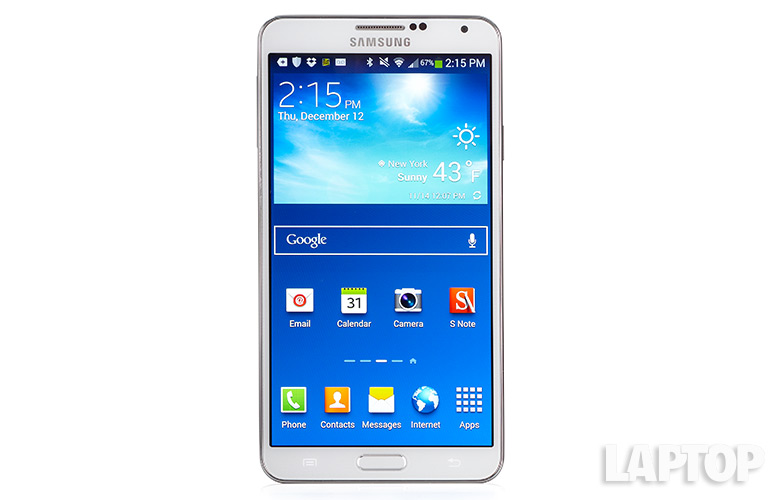
Click to EnlargeThere are a lot of large smartphones on the market, but none takes advantage of its sprawling display the way the Samsung Galaxy Note 3 does. Between the built-in stylus and all of the apps it can be used with, the Note 3 is the most versatile phablet around. We just wish it were able to take advantage of Sprint's Spark network.
Consumers looking for a smaller device should consider the 5-inch Samsung Galaxy S4, the 4.7-inch HTC One or the 4-inch Apple iPhone 5s. But those who want a fantastic combination of long battery life, strong performance and pen-enabled apps should pick up the Galaxy Note 3.
Samsung Galaxy Note 3 (Sprint) Specs
| Alternate Carriers | AT&T, Verizon, T-Mobile |
| Audio formats supported | AMR-NB, AAC+, WAV, AAC, MP3, FLAC, eAAC+, AMR-WB |
| Bluetooth Type | Bluetooth 4.0 LE |
| Brand | Samsung |
| CPU | 2.3-GHz Quad-core ARMv7 Qualcomm MSM 8974 |
| Camera Resolution | 13MP |
| Carrier | Sprint |
| Company Website | www.samsung.com |
| Data | EDGE/GPRS/HSPA+/LTE |
| Display (main) | 5.7-inch HD Super AMOLED display (1920 x 1080) |
| Display Resolution | 1920x1080 |
| Form Factor | Candybar Touchscreen |
| Front Camera Resolution | 2 MP |
| Internal Memory | 32GB |
| Memory Expansion Type | microSD Card |
| Networks | GSM / GPRS / EDGE / HSPA+42 / LTE Cat 4 |
| OS Family | Android |
| Operating System | Android 4.3 |
| Phone Display Size | 5.7 |
| Ports | 3.5mm headphone, microUSB, microSD |
| Processor Family | Qualcomm Snapdragon 800 |
| RAM | 3 GB |
| Size | 5.95 x 3.12 x 0.33 inches |
| Talk / Standby Time | Up to 23 hours talk |
| Video formats supported | H.263, WMV, VP8, VC-1, MPEG-4, H.264 |
| Weight | 5.93 ounces |
| Wi-Fi | 802.11 a/b/g/n/ac |

